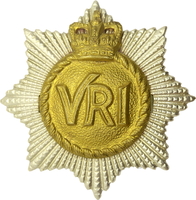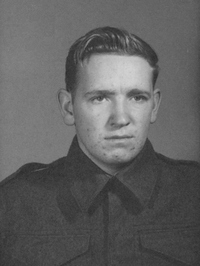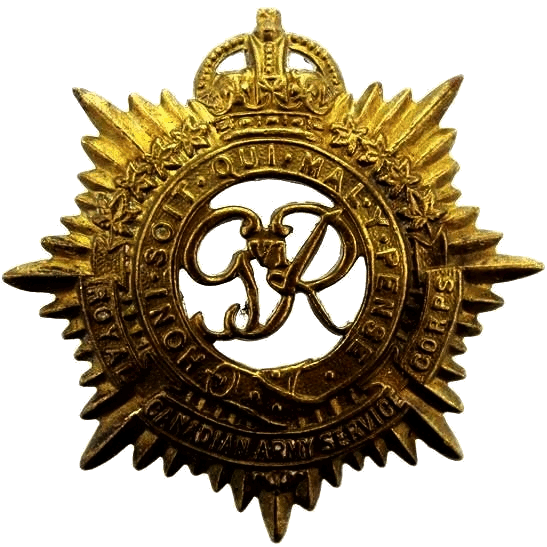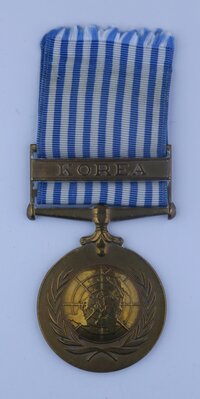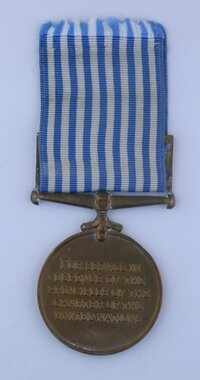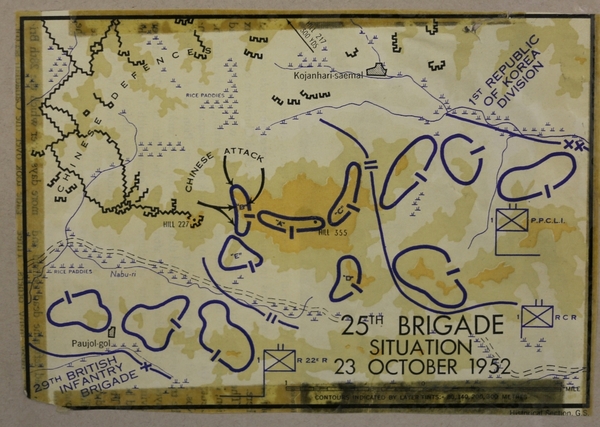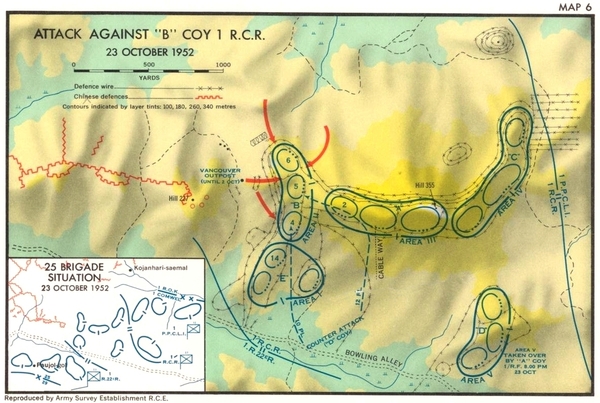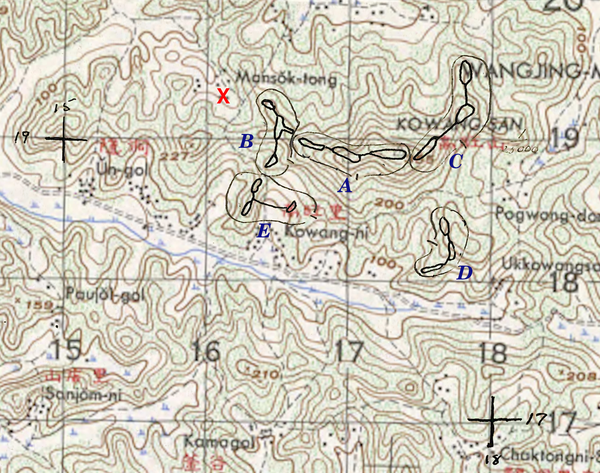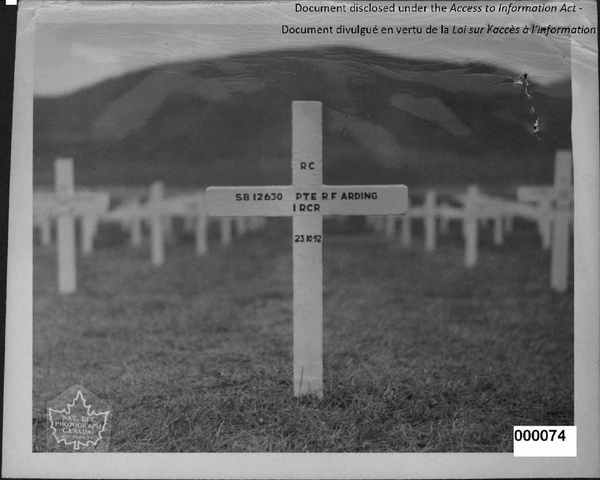
SB12630 Private Robert "Robbie" Francis Arding
Royal Canadian Army Service Corps
The Royal Canadian Regiment
By: Capt (ret'd) Michael M. O'Leary, CD, The RCR
Robert "Robbie" Francis Arding was born in Toronto, Ontario, on 18 Oct 1934 at Toronto, Ont., to parents Robert Henry John and Thelma Ruby (nee Dixon) Arding. Robbie was the second of four surviving children, with older sister Doris Margaret and younger brothers Norman Douglas and Lawrence Gerald. After his mother divorced and remarried, Arding gained another brother, Michael Cherewaty.
Growing up in Toronto, Robbie attended Silverthorn School. In 1948, at the age of 14, he completed Grade VII (having failed in the 5th Grade). He attended Grade VIII for only three months before leaving school to support his mother.
Entering the work force, Arding was first employed by Christie Cleaners from December 1948 to September 1949. He then went to work at Dempster's Staff of Life Bakery as a baker's helper and assistant baker until December 1951. Leaving the bakery, he worked at a used car lot cleaning cars from December 1951 until January 1952 when he enlisted in the Canadian Army (Active Force).
It is noted in Arding's records that he was "ordered to leave home" in December 1951. Although the reasons for this are redacted his file, it is possible that a conflict with his mother's new partner may have been the underlying cause.
After three years of full-time work with three employers, Arding was only 17 years old when he decided to enlist in the Canadian Army, although he claimed a birth year of 1932 making him in the Army's records 19 years old on enlistment. He was medically examined to determine his fitness for service on 12 Jan 1952. Arding's records describe him as 5 feet 6 3/4-inches in height and weighing 173 pounds, with a good physique, fair complexion, fair hair, and hazel eyes. On 14 Jan 1952, he was assigned a PULHEMS medical category of 111111. The PULHEMS physical assessment measured the subject's Physique, Upper Extremity, Lower Extremity, Hearing and Ears, Eyes and Vision, Mental Capacity, and Emotional Stability. A score between "1" and "8" was assigned to each category, with "1" being considered excellent.
As part of his enrolment process, Arding was interviewed by a Personnel Officer on 15 Jan 1952. Notes from that interview include:
"MILITARY BACKGROUND —
"Air Cadets, 1 year – 1947-48
125th Med Bty - 42nd Med Regt RCA (RF) Toronto (service no. B429220) – 1948-50
"ADDITIONAL INFORMATION & APPRAISAL
"ARDING is a young 19 year old recruit with a Grade VII education. He has a satisfactory occupational background with two steady jobs since he left school. He left after a year in the first one because of low wages, and then stayed two years in his next job as a baker's assistant, leaving because he was made an apprentice with an ensuing cut in salary.
"Arding impresses as a clean-cut steady lad who has adjusted well to a difficult home situation. He harbors no resentment against his step-father and feels that he is better off independent. Arding does not drink and has never been in trouble and has no bad habits. His occupational background and motivation are such that he is deemed suitable for training as a tradesman and it is felt that he has the ability to become a potential cook.
"RECOMMENDATIONS – RCASC – Potential Cook
"Personnel Office, #6 Personnel Depot, Toronto, Ont.
D.L. Gold, Capt., Personnel Officer, 15 JAN 52"
Recommended for employment as a cook in the Royal Canadian Army Service Corps (RCASC), Robert Arding enlisted in the Canadian Army (Active Force) on 15 Jan 1952 at No. 6 Personnel Depot (PD), Toronto. He identified his mother, Mrs. Thelma Ruby Arding, 284 Queen St., East, Toronto, Ont., as his next of kin. Arding claimed three years prior service in the Reserve Force. His religious denomination was Roman Catholic. On taking the Oath of Allegiance, Arding committed to a three-year period of service. Granted the pay rate of Private on entry, he was granted seven days leave with ration allowance of $20 per month.
On 22 Jan 1952, Arding was sent from No. 6 PD to The RCASC School at Camp Borden, Ont. One day after his arrival at the School, Arding completed a form on which he identified his preferred army postings for after his training. In order, he requested that he be sent to (1) 27 Cdn. Inf. Bde. (Europe), (2) Canada, (3) 25 Cdn. Inf. Bde. (Korea).
Soon after arriving in Camp Borden, Arding as was struck off the strength of The RCASC School on 3 Feb 1952 and transferred to 56 Transport Company, RCASC. The history of the RCASC, The Last Waggon (Murray, 2001), provides some details of this Company's creation and purpose, and also the types of soldiers Arding was thrown in with at this stage of his military service:
"No 56 Transport Company (not to be confused with 56 Canadian Transport Company of UNEF) was authorized effective 1 August 1951. Like its sister field companies, it was formed and based in Camp Borden and it was trained for Korean service. Maj E.G. Hession was the first OC … S/Sgt H.G. (Harold or "Johnny'') Saunders was the CSM. This staff, with the assistance of The RCASC School, assembled and trained 56 Tpt Coy during late 1951 and early 1952.
"Like the other transport companies, 56 Tpt Coy's initial preoccupation was with recruit training. As a result, its first offices were in The RCASC School's Basic Training Wing lines and its quarters bordered the parade square. The horror stories about the quality of the recruits joining the Corps in 1951/52 were doubly true in 56 Tpt Coy. As it was formed about three months after 55 Tpt Coy and was not scheduled to proceed overseas for eighteen months, its manning priority was well below that of the Germany-bound 55 Tpt Coy. Some of the recruits had undisclosed criminal records, others claimed World War II service and medals to which they were not entitled, and several others, who were not disciplinary problems, were illiterate. As they did not create an immediate problem, many in this last group were able to conceal their illiteracy for several years. Luckily, Maj Hession had an uncanny ability to detect these service anomalies and many orderly room cases resulted. However, it was extremely difficult to train a recruit class when many of the soldiers were in the detention barracks.
"The parallel events in 55 and 56 Tpt Coys are amazing. Not only did both reject large numbers of recruits but both sent an officer for Adjutant General's disposal and both saw fit to replace their first CSM.
"When in-unit recruit training was completed and the company was almost up to establishment strength, it moved north to the "O" lines of Camp Borden. Advanced training then began in earnest, however, this did not extend to field transport exercises as the unit had not yet been issued its vehicles. At this time, some of the more promising soldiers were returned to The School to be trained as cooks and clerks for the unit.
"By the summer of 1952, 56 Tpt Coy was ready to proceed on its first great adventure. It moved to Wainwright, Alberta, by rail, for a summer concentration." (The Last Waggon, pp. 55-56)
As a new soldier in 56 Tpt Coy, Arding commenced Basic Training on 11 Feb 1952. Nearly two months later, on 29 Mar 1952 he was formally transferred from the Company to The RCASC School. Two days after that, Arding completed his Basic Training course. On graduating, he was upgraded to Private, 2nd Class, with the accompanying increase in pay.
Continuing with training in his army trade, Arding started a new course on 7 Apr 1952 to become an RCASC cook. During a 16-week course of instruction under the Catering Training Company, Arding and his fellow trainees were taught the Theoretical Aspects of the Catering Services, Butchery, Bakery, Field Cookery, and Mess Cookery.
Midway through his cook's training, Arding must have decided he needed a break from the routines of army life. On 18 Jul 1952, he went AWOL, and was absent until 25 Jul 1952. Charges being prepared immediately after his return, Arding was subject to a summary trial on the same day he reported back to the School. On 25 Jul 1952, Arding was charged with having been away without leave from 1100 hrs 18 Jul 1952 until 0230 hrs 25 Jul 1952. Found guilty of the offences of absence (Sect 81, NDA) and an act to the prejudice of good order and discipline (Sect 118, NDA), he was sentenced to 14 days Confinement to Barracks (CB) and given a fine of $10.00. In addition, he forfeited seven days pay for the period he was absent.
Arding completed his training on 2 Aug 1952, passing #57 Basic Cook Course and qualifying under the Canadian Army Training School (CATS) Specifications as Cook Group I. His performance as a student was described on his course report as:
"This candidate is considered to be average. He is not a very willing worker and must be under constant supervision. With further on job training he could improve. He completed the four weeks special Field Cooking Familiarization Course."
"Instructional or leadership abilities were not evident."
"This candidate should be employed under the direction of a capable NCO Cook who will assist and guide him in his career. He should not be given any responsibilities until he has improved considerably in the trade."
Two weeks after graduating from his cook's course, Arding was well aware of where the Army was planning to send him. He had been selected for his third choice of postings, Korea. On 16 Aug 1952, he went on six days Annual Leave with an additional three days Embarkation Leave. During this period he also received a Ration Allowance based on a rate of $20.00 per month.
On 27 Aug 1952, Arding and nine other cooks, among a variety of other Service Corps soldiers, were transferred from The RCASC School to No. 11 Personnel Depot, Vancouver. This was their first step in their journey for personnel rotation to 25 Canadian Infantry Brigade in Korea.
After a week in Vancouver, Arding boarded ship for the Pacific crossing. On embarkation, he was struck off the strength of No. 11 PD and taken on the strength of the X-4 List, RCASC. The X-4 List was for personnel who were unposted reinforcements in the theatre of war held by 2 Canadian Administration Unit. Arding would remain on the X-4 List until assigned to a field unit. On sailing, Arding was officially posted to the Canadian Army (Far East). He disembarked in Japan on 16 Sep 1952.
Pte R.F. Arding, RCASC, was struck off the X-4 List on 25 Sep 1952 to be a company cook in an infantry battalion and posted to the 1st Battalion, The Royal Canadian Regiment (1RCR). He was one of three RCASC cooks that joined the unit at the time, the others were SC17254 Pte A.N. Faladeau and SM13953 Pte W. Mudd.
Arriving at the Battalion, Arding and his companions were given their assignments as company cooks. They were also to discover that manning problems experienced by the rifle companies had already established an expectation that cooks and drivers could be called up to stand with their infantry compatriots in the forward trenches and bunkers.
During September and October of 1952, 1RCR occupied battle positions at Kowang San, known as Hill 355 or Little Gibraltar. Companies of the battalion took over their new positions during the night of 4/5 Sep 1952. The other units of the brigade occupied neighbouring positions, the 1st Battalion, Royal 22nd Regiment (1R22eR, the Van Doos), to the southwest and the 1st Battalion, Princess Patricia's Canadian Light Infantry (1PPCLI) to the east and northward. The enemy were also nearby, their most forward position was located on Hill 227 only 600 metres from the Royal Canadian's most exposed position on the west end of Little Gibraltar. Supporting all three battalions were the tanks of the Lord Strathcona's Horse and observation parties of the Royal Canadian Artillery. 1RCR's first day on Hill 355 was marked by casualties, killed and wounded, that would head a growing list of losses over the following two months.
The 1st Battalion's challenges increased on their second day at Hill 355. Caused by a shortage of French-Canadian reinforcements, 1R22eR had regrouped to field only three rifle companies instead of the usual four which meant they could not occupy one of their assigned battle positions. The Brigade Commander's solution was to order 1RCR to form a fifth rifle company and occupy the battle position between the two battalions. "E" or "Easy" Company was formed by taking soldiers from each of the other rifle companies and by augmenting their numbers with soldiers from the Battalion Headquarters and from the supporting personnel of A and B Echelons. The creation of Easy Company and the resulting losses of personnel in the other rifle companies meant that the cooks, drivers, and other support trade soldiers were liable for service in the front line bunkers and trenches to strengthen the company positions across the battalion.
During September 1952, the battalion War Diary recorded 4 killed and 23 wounded in action. A count of 1890 mortar bombs and 939 assorted shells landing on the battalion's positions was tallied. 1RCR maintained an active patrolling program and the battalion had a significant accomplishment in the capture of an enemy prisoner by a patrol.
This map shows the general positions of the companies of each battalion in 25 Canadian Infantry Brigade on 23 Oct 1952. 1RCR's five rifle company battle positions are shown as well as the routes of the Chinese assault on "B" Company. (Click image to enlarge.)
The first day of October 1952 set the tone for the coming month. Enemy mortar fire on the exposed and vital ground position held by "A" Company resulted in six deaths and six wounded, the latter number including a trooper of the Lord Strathcona's Horse on the company position. More losses were recorded the following day and in the first two days of the month the battalion had logged over 800 incoming enemy mortar bombs and shells.
With the arrival of almost a hundred reinforcements on the 2nd of October, 1RCR reported a strength on 1001, all ranks, on the 7th of the month. Maintaining five rifle companies, plus the Battalion Headquarters, HQ Company, and Support Company, balanced by the steady flow of troops rearward for rest and leave, meant that the manning challenges of the rifle companies were not solved by the battalion's reported strength.
Early in the month, "B" Company recorded that the arrival of reinforcement would allow the return of the company cooks to cooking duties. On 2 Oct 1952, the War Diary for "B" Company noted: "Our prayers have been answered. Reinforcements arrived today. We get all of 15 which will help a lot. Will bring our platoons up to 30 each. Now we can let our cooks go back to cooking."
Within days, the company War Diary noted that transfers of troops to other duties in the battalion had cancelled their gains. The continuing drain on the company's strength was noted on 6 Oct 1952 with the comments: "The "I" officer requires one soldier to man the Bn OP. Support Coy are getting six. One man to transport. We will be lucky to break even on this last group of reinforcements." By 15 Oct, "B" Company, after suffering losses of two missing and a dozen wounded after a company patrol three days before, reported "A total strength on the ground of 84, including drivers, cooks, etc."
Throughout October, 1RCR reported numbers of the steadily incoming artillery shells and mortar bombs. The Battalion's exposed positions on Hill 355, especially the forward company, received more than a harassing weight of fire, but for weeks it was also not severe enough to signal an imminent attack. The Battalion countered with aggressive patrolling schedules and retaliatory fire from the mortar platoon and supporting artillery on likely enemy positions and points of observation on neighbouring heights.
This map, from the the official history, Strange Battleground; The Operations in Korea and Their Effects on the Defence Policy of Canada (Ottawa, 1966), shows the general layout of 1RCR position on the night of 23 Oct 1952. Also shown are the Chinese assault routes and those of the "D" Company counter-attack. (Click image to enlarge.)
It would become clear that the enemy's steady indirect fire on Hill 355 was not just to wear down the troops occupying the position, but also to confirm their firing data on every trench, bunker, and other feature on the key company position. At last light on 22 Oct 1952, "B" ("Baker") Company relieved "D" ("Dog") Company in that exposed company position. They would bear the brunt of the enemy's attention over the next 36 hours. During the afternoon of 23 Oct 1952, "B" Company reported their fighting strength on the position: 4 Platoon – 17, 5 Platoon – 14, and 6 Platoon – 19. That day, an estimated 3000 mortar bombs and shells fell on the company position. Upon that under-strength company of Royal Canadians would fall the weight of the Chinese assault on Little Gibraltar.
At about 1820 hours on 23 Oct 1952, following a new barrage of mortar bombs on "B" Company and the neighbouring "A" and "E" Companies, the enemy attacked and overran Baker Company's position. Small groups of survivors made it off the position and reached "E" Company to the south and the battalion headquarters to the east. The long build up of heavy harassing fire had provided the enemy the opportunity to push their forces as far forward as necessary to ensure a successful charge under the cover of their final intense mortar barrage.
As the enemy stormed "B" Company's lines, "E" Company was already preparing for the defence of their right flank facing the captured positions. "D" Company moved forward in their counter-attack role, after being relieved in the depth company position by "D" Company of the Royal Fusiliers. The "D" Company counter-attack, with two platoons advancing in a pincer movement from the adjacent company positions, preceded by mortar and artillery fire directed onto the position, was supported by fire from the neighbouring companies and illuminating flares dropped from aircraft. By 0400 hours on 24 Oct 1952, the overrun company position was back in the hands of Royal Canadians.
The regimental history, before detailing the actions of many Royal Canadians who stood out for their performance in the battle, offered the following summation: "It had been a sharp and costly encounter. Total losses came to 18 killed, 35 wounded and 14 missing. All ranks had responded magnificently to the challenge."
Of the 18 dead noted in the regimental history, 16 were Killed in Action (KIA) during the battle, one was killed in the early hours of 24 Oct 1953, and one died of wounds at the 8063rd Mobile Army Surgical Hospital (MASH) on the 24th. Unit Part II Orders identify the 14 missing who were later confirmed as Prisoners of War (POW). The figure of 35 for wounded, mentioned in the regimental history and recently quoted by a Canadian War Museum facebook post, is a number that is more difficult to confirm. Eighteen wounded soldiers were evacuated to medical facilities behind the lines, many of whom were later struck off strength, too badly wounded to return, and are identified in unit orders. Others who were treated at the Regimental Aid Post and returned to duty soon after would not appear in those records. Lastly, the company War Diaries identify numbers of wounded that total a little over 50. One thing is known for certain, and that is "B" Company suffered the majority of the Battalion's casualties on 23 October.
Records at the website for the United Nations Memorial Cemetery at Busan, Korea, include the Report of Interment for each soldier buried there. These reports provide details on each soldier who was received by the Graves Registration Unit. Included in each report is the cause of death and the location of death.
Of the 16 Killed in Action during the enemy assault on "B" Company, 15 of their bodies were found within the company battle positions. One body was located 400 metres forward of the battle position. This is an area of low ground that was a likely approach and evacuation route for the enemy. It is probable that he was taken from the "B" Company position as one of the captured prisoners, but it was there he either succumbed to wounds received when the battle position was overrun, or an enemy soldier chose that place to deliver a fatal wound.
That soldier was SB12630 Private Robert Francis Arding, RCASC, a company cook in "B" Company, 1RCR.
Kowang San (Hill 355) area topographical map, overlayed with the 1RCR battle positions trace from the battalion's War Diary for October, 1952. Indicated are the companies which occupied the positions on the night of 23 Oct 1952. The red "X" indicated the position where Private Robert Arding's remains were recovered. (Click image to enlarge.)
Effective 23 Oct 1952, Robert Arding was struck off the strength of the 1st Battalion, The RCR. The Unit Part II Orders list him with other casualties at Hill 355 under the heading "SOS deceased (Killed in Action)."
A cable to the Director of Records in NDHQ received on 25 Oct 1952 confirmed that Arding was a battle casualty, Killed in Action. The notes on the form give his unit as "1 Bn RCR" and his corps as "RCIC" (i.e., Royal Canadian Infantry Corps). The form notes that there was no will to be sent to the Judge Advocate General.
Arding's name was included on Casualty List No. A-213, dated 25 Oct 1952. A telegram was sent to his mother, Mrs. Thelma Ruby Arding, it read:
"DEEPLY REGRET TO INFORM YOU THAT YOUR SON SB 12630 PRIVATE ROBERT FRANCIS ARDING FIRST BATTALION ROYAL CANADIAN REGIMENT HAS BEEN OFFICIALLY REPORTED KILLED IN ACTION IN KOREA ON OCTOBER TWENTY THIRD STOP FURTHER INFORMATION WILL BE FORWARDED ON RECEIPT – DIRECTOR OF ARMY RECORDS."
Although some documents recorded Arding's death give his unit as 1RCR and corps as RCIC, this was not the case with the Certificate of Identity completed on 24 Oct 1952 by ZA272 Capt. A.G.M. Angus of 1RCR. The form shows that Arding's unit was "RCASC (attached 1RCR)." His death is noted as having occurred "in the field" at map reference "CT 161193." The cause of death states "Deep penetration right femoral canal." Identification of the body was confirmed by Arding's Pay Book.
Robert Francis Arding was buried on 28 Oct 1952 at the United Nations Military Cemetery Tanggok, Korea. He was interred by the US Graves Registration Company, Korea. On their examination of his body and preparation for burial, the graves registration unit noted that Arding had tattoos. On his left forearm were a nude woman and an entwined snake.
Dated 28 Oct 1952, a letter of condolence was sent to Mrs. Arding from National Defence Headquarters. Signed by Major-General W.H.S. Macklin, Adjutant-General, it read:
"It is with deep regret that I learned of the death of your son, Robert Francis Arding, who was killed in action in Korea."
"The Minister of National Defence and the Members of the Defence Council have asked me to express to you and your family their sincere sympathy in your bereavement."
On 29 Oct 1952, The Toronto Star published a brief article about Arding's service and death:
"Enlisted to Help Mother
"Youth, 18, Killed in Korea
"Five days after Robert Francis Arding—"Robbie" to his mother sister, and two young brothers—celebrated his 18th birthday, he died on a Korean battlefield.
"Pte. Arding joined the army to send some money every month to his mother. He started as a cook and did so well during basic training at Camp Borden he was cooking for 150 when when he was posted overseas. He never missed sending his mother $40 each month.
"He wrote just one letter home to his mother from Korea. It came a few hours before the telegram announcing his death. He wrote it by candlelight sitting on a soapbox. He was, he told her, "in the infantry now" and just a mile south of the enemy. …
"He wrote her: "Don't worry about me, mom, it isn't as as it seems." That was Oct 5. On Oct 18 he was 18. He died Oct. 23.
"Pte. Arding enlisted last winter. He was at the age where parental consent was needed. His mother recalled today. "For weeks he pleaded with me, 'Mom, sign me up.' He couldn't get work." We needed money. When he threatened to go to another town and join up—he was five feet, eight inches tall and he looked like a man—I had to give in."
"Popular at Camp
"At Camp Borden, Robbie was popular. He came to his Seaton St. home on his week-end leaves, and "didn't even have a girl friend." Playfully, his mother said, Robbie would give his mother hints on how to cook—"except, where I'd use maybe a pinch of pepper, he'd use a pound," she said.
"Mrs. Thelma Ruby Arding, has two younger sons at home, Norman, 11, and Lawrence, seven.
"The first week in September, Robbie was told he was going to Korea. In his only letter home, he told of leaving Seattle, Sept 6, arriving at Yokohama Sept. 15. hopping to Kure to Korea, stopping en route at Pusan. He arrived up in Seoul, from there to Inchon, and "then the trucks took us to the front."
"He wrote: "Here, we're a mile south of the 38th parallel. The [enemy] are about a mile in front of us. … ask the old man to drop me a few-lines. I guess the old man's pretty proud to have a son fighting jn Korea."
"He wrote that he slept in bunkers in sandbag-reinforced trenches. He said, "The time here is going fast. It won't be long until I'll be back."
"Mrs. Arding got the five-page letter from her son last Saturday morning.
"But at noon, she said, a telegram arrived. It started, "priority" and went on, "we deeply regret to inform you…" She said, "Robbie was a good boy. He was kind to his mother, and good to his brothers. He never did a thing wrong in his life."
Thelma Arding completed forms for the DND Estates Branch at Toronto City Hall on 3 Nov 1952. In addition to providing basic information on her son, she added the following statement:
"It has been a terrible shock to lose my boy at such an early age. I never thought they would send him overseas so quick. Robbie tried hard to find work but couldn't get any and so he joined the army so he could help me out as much as he could. He was one boy in a hundred who sent home some of his pay to his mother, he did say something about him being insured in the army but I don't know just who to see about these things and I would thank you very much if you could do what you could as my heart is too full of grief to speak about my son Robbie yet. He was a good boy to his sister, brothers, and his "Mom" and no one knows the heart-ache we feel at losing him."
"Yours Sincerely, Mrs. Thelma R. Arding."
Under the Defence Services Pension Act, Arding's estate was entitled to receive a return of contributions. This totalled $92.91. There was no entitlement to a pension or service gratuity because Arding left no widow or children who would have received them.
A notecard in Arding's service record dated 22 Nov 1952 confirmed that there was no Assignment for Insurance on his pay account. Two days later, a letter from the Director of Estates confirmed to Mrs. Arding that her son had not made arrangements to pay for insurance.
For his Korean War service in Canada and the Far East, Arding was awarded the Canadian Korea Medal and the United Nations Service Medal for Korea. These were sent to his father, Mr. Robert Henry Arding, 1215 Queen St W., Toronto 3, Ont., on 10 Dec 1952. On the same day, a silver Memorial Cross was sent to Arding's mother, Mrs. T.R. Arding, 245 MacDonnell Ave, Toronto 3, Ont.
On 11 Dec 1952, Arding's mother was sent a letter from the Adjutant-General confirming his burial in the United Nations Military Cemetery, Tanggok (near Pusan) Korea, on 28 Oct 1952. The location of the grave was identified as "Plot Number Allied 21, Row Number 8, Grave Number 1351." Burial rites were performed by Lt-Col Charles W. Loven, Chaplain with the American Forces.
Two months after her son's death, Mrs. Arding received and signed for his son's Personal Effects on 22 Dec 1952. These included:
"1 Cigarette lighter (Ronson)
1 tablecloth (small, coloured)
1 Wallet, black leather containing 5 snapshots
2 Post cards
1 Song sheet
2 Meridian certificates
1 Penlight
1 Unemployment Insurance Card
1 Soldier's Service Book Part 1."
Enclosed with a letter dated 29 Jan 1953, Arding's mother was sent three photographs of his grave in the United Nations Military Cemetery, Tanggok (near Pusan) Korea.
On 1 May 1953, a letter from the Director of Estates confirmed that there was $139.92 to be disbursed from Arding's estate. Notes in his file show that this was to be distributed equally between Arding's father, mother, and three siblings. Robert Henry Arding received $27.99, the balance was sent to Arding's mother for her own share and as guardian of Arding's siblings who were still minors.
Arding was initially recorded in the official Casualty List (No. 148, dated 28 Oct 1952) as a soldier of The RCR. As the records of his death and burial were confirmed, this was corrected to his parent Corps affiliation, RCASC. By the time The RCR was confirming Rolls of Honour for the second volume of regimental history (Stevens, 1967), Arding's connection to the Regiment was overlooked in the review of available records. This also resulted in his name not being included when the Books of Remembrance were reviewed by this author about 2006 in an update to the Regiment's Rolls of Honour. This omission is now corrected.
The death of Robert Arding was mentioned in John Melady's "Korea: Canada's Forgotten War." Melady quoted from the Toronto Star article, but dug no further. While making a point about the tragic loss of a young soldier, he did not include the date or circumstances of Arding's death.
If anyone had looked more closely, they might have asked: How does a young RCASC cook get killed in action and his body recovered from a location 400 metres forward of the infantry's battle positions? Arding's case is a good example of the need for continuing research into the Regiment's soldiers and how we have recorded their service and sacrifice.
The wooden cross which first marked Private Robert "Robbie" Arding's grave in the United Nations Military Cemetery, Tanggok (near Pusan) Korea. Photo source: Arding's service record held by Library and Archives Canada. (Click image to enlarge.)
THE KOREAN WAR ROLL OF HONOUR
(THE RCR)
SB-12630 Private Robert Francis Arding
SF-30476 Lance Corporal Patrick Gerald Redmond
Research into the regimental service of a Korean War casualty, Pte Robert Arding, led to the identification of two soldiers of the Royal Canadian Army Service Corps who should have been included on the Roll of Honour for The Royal Canadian Regiment. Both soldiers were company cooks and they were killed in action while serving with The RCR.
The above research on Pte Arding prompted a review of other RCASC casualties in Korea in order to identify if any others were serving with The RCR at the time of their deaths. In this review, a second soldier was identified.
SF-30476 L/Cpl Patrick Gerald Redmond
Lance Corporal Redmond was Killed in Action at Hill 187 on 22 Apr 1953.
Details of Redmond's service can be found in the Part II Orders of the 3rd Battalion, The Royal Canadian Regiment (3RCR):
- Taken on strength (TOS) from 1RCR, 6 Jan 1951.
- TOS CASF (USA) having been Struck off Strength (SOS) CASF (CAN) the preceding day, 8 Jan 1951.
- To draw pay of Cook Gp 2, SF - Pte Redmond PG, RCASC, 23 Feb 1951.
- Qualified under CAT Specs as Cook Gp 2, 23 Feb 1951.
- Embarked Canada, 3 Mar 1953.
- SOS deceased (Killed in Action) at 1445 hrs, 22 Apr 1953.
Redmond's death is mentioned in the War Diary of "A" Company, 3rd Battalion, The RCR:
IN THE FIELD [The battalion was located at HILL 187]
22 April 1953
"Morning uneventful. Enemy started mortaring and shelling the coy at 1445 hrs, 5 rds dropped in area. One round was a direct hit on the kitchen killing L/Cpl REDMOND and wounding Pte GAUDET and Cpl DOWNS plus four KSC [Korean Service Corps] kitchen workers."
The regimental history (Stevens, 1967, p. 265), notes "As Third Battalion was considerably stronger than the "Van Doos" the construction of additional bunkers and weapon pits began. This naturally led to shelling and on April 22nd both A and B Companies reported their first casualties. An A Company kitchen was hit, one other rank being killed and six (including four Korean helpers) being wounded."
L/Cpl Redmond was recorded in Korean War casualty lists and later in the Books of Remembrance and the Canadian Virtual War Memorial by his parent corps of RCASC.
Both L/Cpl Redmond and Pte Arding were killed in action while serving in Korea with The Royal Canadian Regiment. Neither were included in the Regiment's Roll of Honour in the second volume of regimental history. Later reviews of accessible data listing them as soldiers of the RCASC led to their not being identified as regimental casualties for Roll of Honour updates.
L/Cpl Redmond and Pte Arding have now been added to the Regiment's Roll of Honour of The RCR for Korea. Their names will be annotated with the designation of their parent corps (RCASC) in a similar format to that done for soldiers of other parent regiments (Regular and Reserve) who died while serving with the Regiment in Afghanistan.
Pro Patria
Michael M. O'Leary
Capt (ret'd), The RCR
Regimental Archivist
Pro Patria
Visit a randomly selected page in The O'Leary Collection (or reload for another choice):
- The O'Leary Collection; Medals of The Royal Canadian Regiment.
- Researching Canadian Soldiers of the First World War
- Researching The Royal Canadian Regiment
- The RCR in the First World War
- Badges of The RCR
- The Senior Subaltern
- The Minute Book (blog)
- Rogue Papers
- Tactical Primers
- The Regimental Library
- Battle Honours
- Perpetuation of the CEF
- A Miscellany
- Quotes
- The Frontenac Times
- Site Map
QUICK LINKS
The O'Leary Collection—Medals of The Royal Canadian Regiment
Newest additions:
![]()
![]() SB-12725 Private Henry "Hank" Ard
SB-12725 Private Henry "Hank" Ard ![]()
WIA at Hill 187, Died of Wounds in Japan
![]()
![]() 2355331 Lance Corporal Albert Lorking
2355331 Lance Corporal Albert Lorking
Wounded in action, later a War Amps representative.
![]()
![]() 4334 / 477996 Pte Isaac Hamilton Wilcox
4334 / 477996 Pte Isaac Hamilton Wilcox
Permanent Force, South Africa, and C.E.F.
![]()
![]() 477019 Private Harold Ashcroft
477019 Private Harold Ashcroft
Transferred to the Tunnelers.
![]()
![]() 734231 Private Clark D. Thompson
734231 Private Clark D. Thompson ![]()
The older Thompson brother, killed in action.
![]()
![]() 733849 Private Norman Parker Thompson
733849 Private Norman Parker Thompson
The younger Thompson brother; post-war service in the Special Guard.
![]()
![]()
![]() A305 / 400305 Private Andrew Walker
A305 / 400305 Private Andrew Walker ![]()
"Previously reported Wounded, now Killed in Action."
![]()
![]() 823298 Pte Thomas Patrick Steele, M.M.
823298 Pte Thomas Patrick Steele, M.M. ![]()
… for gallant conduct in the field …
![]()
![]() P13066 Sergeant Harold Thompson
P13066 Sergeant Harold Thompson
Instrumental Soloist for over 20 years of Canadian Army service.
![]()
![]() 9609 / 477728 Private Albert Edward Piper
9609 / 477728 Private Albert Edward Piper
"Arrived from England as a STOWAWAY …"
